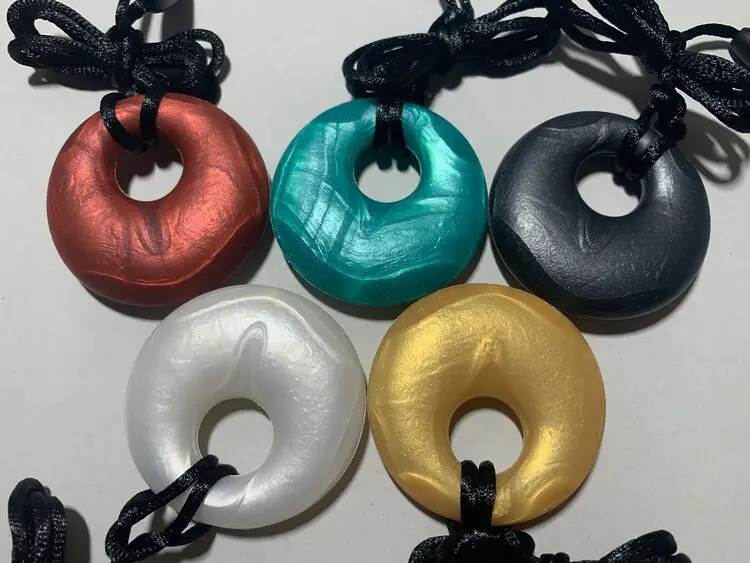Excessive mouthing of objects is a typical behavior for infants and toddlers as they start to learn about the world. “Mouthing” refers to children placing objects in their mouths. It is a significant part of their early learning and development.
The primary way infants explore the world is through their senses of touch and taste. Infants’ vision is not fully developed at birth, and the mouth serves as the exploration cave for babies. The mouth is one of the most sensitive parts of the human body, equipped with abundant sensory receptors ready for exploration.
Further, it allows babies to gather extensive sensory information about texture, temperature, shapes, size, and taste. During infancy and toddlerhood, placing items in the mouth is accepted. Furthermore, learning about the properties of the objects in the environment through mouthing is a critical part of early development.
Mouthing Stages in Babies:

Newborn to 3 Months:
- Rooting Reflex: Right from birth, babies will turn their heads and open their mouths when the corner of their mouth is stroked or touched. This infant behavior is called the rooting reflex, which helps them find the breast or bottle for feeding.
- Exploratory Mouthing: Even in these early weeks, babies might suck on their hands or fingers. It is a sign of hunger and a way they start to self-soothe and explore.
3 to 6 Months:
- Hand Discovery: Babies become increasingly aware of their hands. You’ll notice them studying, bringing their hands together, and often bringing them to their mouths.
- Teething Onset: While teething can start anytime (and for some, a bit later), initial signs may begin in this period. Teething can increase the baby’s desire to chew on things, including their fingers, to relieve gum discomfort.
6 to 9 Months:
- Introduction of Solids: As many babies start on solid foods around 6 months, they’ll experiment with textures with their hands and mouths.
- Improved Motor Skills: Mouthing is part of how infants improve hand-eye coordination. Grasping objects and bringing them to the mouth is one of the early motor milestones. Mouthing is still a primary way of exploring textures, shapes, and the world around them.
- Active Teething: Many babies will have their first tooth eruption during this period, making teething toys and other safe objects crucial for gum relief.
9 to 12 Months:
- Pincer Grasp Development: Babies use their thumb and first finger to pick up objects, increasing their ability to explore smaller items with their mouths.
- Increasing Dietary Exploration: As babies eat a more varied diet, they’ll experiment more with different food textures, shapes, and tastes.
- Safety Concern: With the ability to explore smaller objects and the natural curiosity to put them in their mouths, this stage poses an increased risk of choking. It’s crucial to ensure their environment is safe.
12 Months and Beyond:
- Toddlers and Older Infants: While the intensity of mouthing might decrease, many toddlers continue to explore objects with their mouths, especially during teething spurts or when encountering new textures and materials.
- Language Development: As babies babble and form words, they’ll use their mouths differently, exploring sounds and practicing speech patterns.
Indeed, parents and caregivers should always be vigilant during the early development stages. Providing safe, appropriate toys and objects for mouthing while ensuring that potential choking hazards are out of reach is vital. It’s also helpful to understand that while mouthing is a natural developmental behavior, keeping the child’s environment clean and safe is essential, especially as they become more mobile and curious.

Why Older Children Are Mouthing Objects
Sensory Seeking Behavior: Some children, particularly those with sensory processing disorders or conditions like Autism Spectrum Disorder (ASD), may mouth objects to seek additional sensory input. It can help them self-soothe, regulate their emotions, or focus.
Habit: For some children, mouthing objects may become a habit that they continue into older childhood, particularly when they feel stressed, anxious, or bored.
Attention-Seeking Behavior: Some children may mouth objects to attract attention from adults or peers, especially if they have learned that this behavior elicits a reaction.
Medication Side Effects: Certain medications might cause older children to exhibit unusual behaviors, including mouthing objects, due to altered sensory experiences or cognitive functions.
Hunger or Malnutrition: In rare cases, older children may mouth objects due to extreme hunger or malnutrition as they might be trying to find something to eat.
Curiosity: Just as younger children explore the world orally, older children might occasionally use mouthing as an explorative or contemplative behavior.
Oral Discomfort: New teeth coming in might cause discomfort and pain. Chewing on objects can provide relief by applying pressure to the gums. Ensure the gums are intact and there is no damage to the tooth or cavity.

Excessive Mouthing Concerns
Age Inappropriateness: If a child older than 3-4 years continues to mouth objects frequently and excessively, especially non-food items, it might warrant attention. While some older children may occasionally mouth things, it should not be a primary method of exploration or soothing.
Interference with Daily Functioning: If the mouthing behavior interferes with the child’s ability to participate in typical activities, play, or social interactions, it might be an area of concern.
Risk of Harm: If a child is mouthing objects that are toxic, unsanitary, or pose a choking hazard, it’s an evident safety concern.
Pica: Pica is characterized by eating non-food items. If a child is mouthing and consuming inappropriate objects such as dirt, paint chips, rocks, or other non-food substances, this is a cause for concern and warrants immediate intervention.
Developmental or Behavioral Concerns: If excessive mouthing is seen alongside other signs of developmental delays or behavioral issues, it can indicate an underlying condition, such as a sensory processing disorder or Autism Spectrum Disorder (ASD).
Intensity and Frequency: Occasional mouthing might not be worrisome, but it’s more concerning if the behavior is intense and persistent.
Signs of Dental or Oral Damage: If a child’s mouthing behavior is leading to damage to their teeth, gums, or inside of their mouth, it’s a reason for concern.
Signs of Distress: If a child seems distressed and uses mouthing as a predominant means of self-soothing, it might indicate unmet needs or emotional distress.
Developmental Regression: If a child who has stopped mouthing objects starts doing it again, it might signal stress, anxiety, or other underlying issues.
Therefore, when children continue mouthing objects beyond 2 to 3 years old or if the behavior seems intense, frequent, and difficult to redirect, it could indicate developmental, behavioral, or sensory-processing concerns that might warrant attention and potential intervention.

Addressing Excessive Mouthing Concerns
Medical Evaluation: It’s important first to rule out medical or nutritional deficiencies. For example, if the child is found to have pica, this could indicate a lack of iron deficiency anemia.
Behavioral Assessment: Conducting a comprehensive behavioral assessment can help pinpoint triggers and determine whether the mouthing is sensory-seeking, a result of anxiety, or a habit.
Occupational Therapy Assessment and Treatment: An occupational therapist, especially experienced in sensory integration, can offer strategies and interventions tailored to the child’s need, for example:
- A program to address sensory needs to help the child stay in a calm-alert state.
- A sensory-based oral motor program.
- A sensory diet that includes activities for sensory modulation and oral motor activities. Sensory diets that meet oral needs include sucking, chewing, biting, crunching, blowing, hot, cold, sour, bitter, and other sensory food characteristics.
- A behavioral-based program that reinforces the desired behaviors and teaches replacement behavior while extinguishing the mouthing.

Safe Alternatives: For children who seek sensory input through mouthing:
- Offer chewelry (chewable jewelry) or sensory chew toys made of safe, non-toxic materials. Chewies are considered socially appropriate, and it is used to meet a child’s sensory need to chew.
- Chewies are commercially available in many forms, in the form of teethers, jewelry, pencil toppers, clip-on chewies or fidgets, chewy tubes, soft chewelry, necklaces, bracelets, or other FDA-approved items.
- Oral sensory tools, like textured spoons, mouth brushes, and vibrating oral tools.

Behavioral Interventions:
- Positive reinforcement: Reward and praise the child when they refrain from mouthing.
- Redirect: If they begin to mouth an object, redirect them to a more appropriate activity or item.
- Set clear boundaries: Make sure they know which items are okay to mouth and which are not.
Environmental Modifications: Remove or reduce access to non-safe items that the child tends to mouth. Ensure their environment is free from small objects that could be a choking hazard or pose a risk if mouthed.
Counseling or Therapy: For children who mouth objects due to anxiety, stress, or trauma, counseling or therapy might be beneficial.
Consistent Communication: Consistency is critical. Ensure all caregivers, educators, and family members are on the same page regarding strategies and interventions.
Education: Teach the child about the dangers associated with mouthing particular objects. Depending on the child’s cognitive abilities, they might benefit from understanding the “why” behind specific rules.
Monitor Medications: If a child has started a new medication and you notice increased mouthing or other unusual behaviors, consult the prescribing doctor about potential side effects.
Regularly Check Developmental Progress: For children with developmental delays, regular check-ins with pediatricians or developmental specialists can help adjust strategies as the child grows and evolves.

Summary
The mouth is a primary sensory organ through which infants explore and learn about their environment. Mouthing is a developmental stage where babies and toddlers put objects in their mouths to learn about their texture, taste, temperature, and other properties. It’s an essential part of their sensory development and helps babies understand the world around them.
Concerns should arise if a child continues to excessively mouth objects beyond the developmental stage. When older children mouth objects, it’s essential for caregivers, educators, and healthcare providers to explore the underlying reasons for this behavior. Particularly if it risks the child’s health and well-being or interferes with their daily tasks.
Above all, every child is unique, and finding the underlying cause of the mouthing behavior is crucial to providing the proper support. Furthermore, it is critical to investigate and understand the specific reasons for each child’s behavior to provide appropriate intervention. Often, thorough professional evaluation and assessment will provide insight and help manage behaviors effectively.
If you enjoyed this article, please share it with a friend!
Discover Why Messy Play is Important
Fun Animal Walk Exercises for Children
Everything You Need To Know About Midline Crossing
Nature Play – 7 Benefits For Child’s Growth
Powerful Sensory Integration in Children
*Kids Groove and Grow participates in the Amazon Services LLC Associates Program, an affiliate advertising program designated to provide means for sites to earn advertising fees by advertising and linking to Amazon.com.


0 Comments